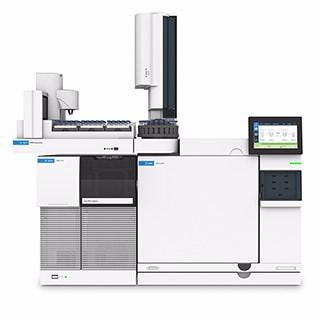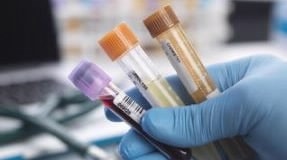
Unequivocal GC/TQ intelligence and diagnostics
7000E Triple Quadrupole GC/MS
Method development beginning with SIM, scan, or MRM data, and method migration from the Agilent 5975 or 5977 GC/MSD can be done with ease using the fully automated MassHunter Optimizer for GC Triple Quadrupole. Using new data acquisition modes including triggered MRM and simultaneous dynamic MRM and scan (dMRM/scan), you can confidently confirm target analytes and perform retrospective analysis at any point in the future without the need for reinjection.
- GC/MS Instruments
Product Details
- The new HydroInert source enables easy adoption of hydrogen as a carrier gas, improves chromatography, and helps prevent operational disruptions due to helium shortages
- Data acquisition modes like data-dependent tMRM and simultaneous dMRM and scan mode enable targeted screening with confident quantitation of hundreds of analytes in a single run
- Twice as fast SWARM autotune with incorporated diagnostic features pairs with the built-in intelligence of the 8890, 8850, and Intuvo GCs for improved system diagnostics and simplified access to powerful operations through an integrated touch screen and browser interface
- JetClean self-cleaning ion source greatly reduces or even eliminates the need for manual source cleaning
- A heated gold quadrupole, triple-axis HED-EM detector, and fast venting enhance the performance of the mass spectrometer by reducing neutral noise and instrument cool-down time
- Agilent MassHunter software delivers complete control from tune to data analysis and report generation, streamlining your workflow
- MassHunter Optimizer software easily transfers GC/MSD methods to GC/TQ and uses retention time locking software to reproducibly transfer methods between GC systems
- Built-in technical controls combined with procedural controls ensure the security of your data, control access, and facilitate compliance as defined by US FDA 21 CFR Part 11, EU Annex 11, and similar national electronic record regulations
- The Agilent Pesticides and Environmental Pollutants 4.0 Database contains over 1,100 compounds with multiple transitions per compound and over 7,500 matrix-optimized MRM transitions, helping you build acquisition methods that reduce matrix interferences
- To enable a better-informed, sustainable choice, Agilent has partnered with My Green Lab to have the 7000E GC/TQ independently audited for their Accountability, Consistency, and Transparency (ACT) label
| Detector |
|
| Dimensions (WxDxH) |
|
| GC/MSD Method Compatibility |
|
| IDL Sensitivity (positive) |
|
| Ion Source |
|
| JetClean Compatibility |
|
| MRM Speed |
|
| Mass Range |
|
| Minimum MRM Dwell Time |
|
| Mode of Operation |
|
| QuickProbe Compatibility |
|
| Software Platform |
|
Gas Chromatography Mass Spectrometry (GC-MS) Information
What is GC-MS? GC/MS combines two analytical tools to identify and measure the concentration of chemicals found in foods, consumer products, pharmaceuticals, fuels, the environment, and more. Read on to learn more about the typical components of a GC/MS instrument and its basic principle of operation.
Learn More- Application Notes
-
Analysis of 197 Pesticides in Durian by Agilent PAL 3 Autosampler and 7000E Triple Quadrupole GC/MSD
Analysis of 197 Pesticides in Durian by Agilent PAL 3 Autosampler and 7000E Triple Quadrupole GC/MSD
- Application Notes
- English
- 21 Oct 2025
- 5.16 MB
Application of Py-GC-MSMS for Microplastic Analysis in Samples Containing Interfering Substances
In this application note, we applied Py-GC-MSMS (MRM mode) to microplastic analysis to determine whether it can be used to analyze microplastics in samples containing interfering substances.
- Application Notes
- English
- 23 Apr 2025
- 1.16 MB
Hydrogen Carrier Gas for GC/MS/MS Analysis of Steroids in Urine in Under 10 Minutes
This application note discusses a validated GC/MS/MS method for the quantitative analysis of 14 endogenous anabolic steroids in urine, using hydrogen carrier gas.
- Application Notes
- English
- 26 Mar 2025
- 971.75 KB
A Forensic Triple Quadrupole GC/MS MRM Database for Forensic and Toxicological Workflows
The forensic toxicology database with curated set of 1,804 MRM transitions for 176 toxicologically-relevant compounds was successfully developed. The developed MRM database can be used for simplified data acquisition method creation, providing a valuable resource for the development of screening and quantitation methods in forensic labs.
- Application Notes
- English
- 21 Jan 2025
- 1.65 MB
Ensure a Healthier World from the Ground Up
GC/MS solutions for environmental and food testing
- Application Notes
- English
- 05 Dec 2024
- 16.84 MB
Indoor Air Analysis of Fluorotelomer Alcohols and Per- and Polyfluoroalkyl Substances
An Agilent 8890 GC with an Agilent 7000E GC/TQ is used for the analysis of fluorotelomer alcohols (FTOH) in indoor air samples.
- Application Notes
- English
- 10 Oct 2024
- 209.58 KB
Highly Selective GC/TQ Analysis of 57 Allergens in Cosmetic Products
Highly selective GC/TQ analysis of 57 allergens in cosmetic products, featuring the Agilent 8890 GC and Agilent 7000E GC/TQ.
- Application Notes
- English
- 09 Oct 2024
- 417.06 KB
Analysis of Dithiocarbamate Pesticides in Tea Using GC/MS/MS
Analysis of ditiocarbamate pesticides in tea by Agilent 8890/7000E and 8890/7010 Series GC/TQ systems.
- Application Notes
- English
- 06 Aug 2024
- 1.78 MB
Quantification of Nitrosamine Impurities in Sartan Drugs Using an Agilent GC/TQ with Hydrogen Carrier Gas
Hydrogen carrier gas for analyzing nitrosamines in sartan drugs with Agilent 8890/7000E and 8890/7010 Series GC/TQ systems under unified compliance.
- Application Notes
- English
- 23 May 2024
- 1.21 MB
Automated Sample Preparation Using Agilent PAL3 RTC for EPA 8270E SVOC Analysis by GC/TQ
Automated Sample Preparation Using PAL3 RTC System for EPA 8270E Method for Semivolatile Organic Analysis by GC/TQ
- Application Notes
- English
- 08 Feb 2024
- 772.66 KB
- Brochures
- Flyers
- Posters
- Technical Overviews
- FAQs
-
Instrument Detection Limit Frequently Asked Questions (FAQ)
An Introduction to Using Instrument Detection Limit as a Performance Metric
- User Contributed Software
- User Manuals
More help is just a click away.
If you didn’t find what you need, try these resources or contact a specialist.
Forensic Toxicology Triple Quadrupole GC/MS MRM Database
A curated set of 1,804 MRM transitions for 176 toxicologically relevant compounds. (For Forensic Use)
Essential Supplies for GC/MS Workflows
These top supplies are recommended by Agilent technical experts to optimize your GC/MS workflows.
GC Productivity Tools
Download method translation software plus calculators for vapor volume, pressure flow, solvent vent, and CFT.
Helium Conservation Cost Savings Calculator
See how much helium and money you could save using Gas Saver and a helium conservation module for nitrogen standby.
Videos
Agilent 8850 GC with Expanded Capabilities Lets You Do More Than Before
The fast, compact, energy-efficient 8850 GC has new features that enable more labs to perform more methods and process more samples. It is now compatible with Agilent single quadrupole and triple quadrupole mass spectrometers. The Multimode Inlet provides greater sample introduction flexibility. A PAL3 Series 2 autosampler system significantly increases sample capacity and allows comprehensive automated sample preparation. A higher maximum oven temperature expands the number of applications that are possible. Backflush improves lab productivity and lowers operating costs.
- 18 May 2025
Agilent Launches New J&W Ultra Inert Columns with Ultra Low-Bleed Technology
The new J&W 5Q columns combine Agilent's industry-leading Ultra Inert performance with Ultra Low-Bleed technology, delivering the new standard for MS column performance and productivity. 5Q columns provide exceptional peak symmetry and minimal column bleed enabling high sensitivity, mass spectral integrity, and accurate quantitation for the most challenging, trace-level analytes. 5Q columns are also designed to optimize sample throughput with fast conditioning and outstanding durability even at high operating temperatures.
- 01 Aug 2024



